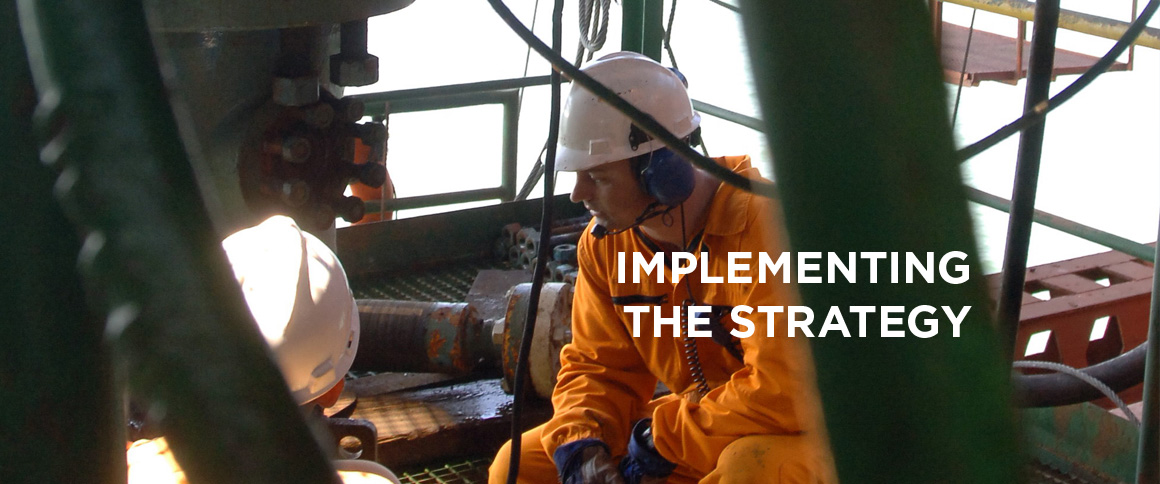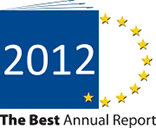

Grupa LOTOS S.A. - Integrated Annual Report 2012
Achievements
PAGE CONTENTS
{GRI 2.2.}
2012 was another record year for the Grupa LOTOS refinery. The Gdańsk refinery processed 9.67m tonnes of crude, the highest in the refinery's history and equal to an average annual utilisation rate of its installed capacities slightly exceeding 92%. Utilisation was adjusted during the year to reflect the prevailing market conditions. Throughput was increased in periods with high refining margins, for example in September and October 2012, when the utilisation rate exceeded 100%.
Source: Grupa LOTOS in-house data.
As in previous years, the main type of crude processed was Russian REBCO. Its share in the total volume was approx. 90.2%, which remained relatively flat in 2011. Crude oil imported by sea, including approx. 180,000 tonnes of Rozewie crude supplied by LOTOS Petrobaltic, accounted for the balance of the crude used. The selection of crudes for processing was based on output optimisation, using emerging opportunities to increase the refinery's processing margin.
Apart from crude oil, other production inputs included fuel components and feedstock purchased for further processing, as well as enhancing additives. This last category consists of biofuels (ethanol, ETBE and FAME), which are added to fuels to achieve the National Indicative Target. In 2012, the long-awaited change in quality requirements applicable to liquid fuels finally came into force. On February 7th 2012, quality requirements for liquid fuels were changed by virtue of the Minister of Economy’s regulation, whereby the permitted content of fatty acid methyl esters (FAME) in diesel oil was increased from 5% to 7%. As a result, on February 14th 2012, the first batch of diesel oil with a 7% FAME content (B7) was produced at the refinery. This change made it possible to attain the National Indicative Target in 2012 with minimum sales of 100 per cent biodiesel (B100).
Source: Grupa LOTOS in-house data.
Another significant event in our refining operations was the commissioning of a high pressure gas pipeline, constructed in partnership with Polskie Górnictwo Naftowe i Gazownictwo and Pomorska Spółka Gazownictwa. Prior to this, the Gdańsk refinery had very limited access to natural gas. Connection of the pipeline, along with pressure reduction stations, enabled the refinery to considerably increase consumption of this environmentally-friendly and cost-efficient fuel. Natural gas is used at the Grupa LOTOS refinery as fuel in process furnaces, the Company’s CHP plant boilers, and as feedstock for hydrogen production. In the production of hydrogen, it replaces the previously used fuel oil and liquid gas. As a result, the carbon footprint of our refining operations was substantially reduced.
In 2012, the refinery's monthly gas consumption had increased from 2,500 tonnes to approximately 35,000 tonnes. By the end of the year, two out of four boilers in the CHP plant had been switched to gas. Following modernisation of the other two boilers, natural gas consumption will increase even further.
Source: Grupa LOTOS in-house data.
Source: Grupa LOTOS in-house data.
In terms of product portfolio diversification, the May 2012 launch of the xylene separation unit at the Grupa LOTOS refinery was also a major event. The unit relies on reformate as feedstock (the high-octane value components used in the manufacture of gasolines). From the reformate, the xylene fraction is recovered – hydrocarbons used in the petrochemical industry. This helps reduce the number of motor gasoline components, which tend to be less in demand in Poland and Europe, while obtaining a valuable non-fuel raw material. In 2012, the xylene separation unit produced some 28,000 tonnes of xylene fraction.
The total output of finished products in 2012 was approximately 9.8m tonnes. As usual, diesel oils accounted for the largest share in total sales (nearly 47%).
Utilisation of the refinery's installed capacity was primarily dependant on the optimum crude processing volumes in the period, as well as the potential of the processed crudes. The higher volumes of crude processed and the lower production of bitumen components led to increased load on the hydrocracking units. Thanks to the unique process system in place at the unit for vacuum residue deasphalting, the Gdańsk refinery is capable of earning an additional margin on the processing of vacuum residue into fuel.
Source: Grupa LOTOS in-house data.
Source: Grupa LOTOS in-house data.
Maintenance
As regards maintenance and overhaul management, our major achievement in 2012 was maintaining the main and ancillary process units' availability at above 99.2%, placing Grupa LOTOS among the best performing refineries in Europe according to the Solomon Report. This strong service factor helped us deliver on production plans.
The safe, stable operation of the main and ancillary processing units was achieved with professional technical and process support, consistent improvement of personnel qualifications, introduction of modern workplace organisation and information flow methods, use of project management techniques in our modernisation and overhaul projects, and development of technical failure prevention strategies. Overhaul and maintenance costs for all these tasks were fully optimised through leveraging of the potential of the LOTOS Group's subsidiaries.
In 2012, we also launched our technical risk management programme. Working with the Office of Technical Inspection we ran a pilot test of the RBI (Risk Based Inspection) methodology – used for planning inspections by analysing identified risks – on the CCR reforming unit and the atmospheric distillation unit. Implementation work continues on other units.
Grupa LOTOS' refinery is one of the newest and most advanced production plants in Europe. Its excellent condition is chiefly attributable to the 10+ Programme, which was completed in 2011. Even though the refinery has been in operation for nearly 40 years, the average in-service life of its installed units is approximately 11 years.
Capital expenditure
Two of the most important projects completed by Grupa LOTOS in 2012 were:
- The connection of the refinery to a natural gas supply (introducing natural gas as a fuel in the process furnaces and as feedstock in hydrogen production). This project has delivered substantial economic and environmental benefits - we are now able to place three times as much LPG on the market and significantly reduce the refinery's environmental footprint;
- The construction of a xylene separation unit, which enabled us to market a new product, xylenes, which may be used as intermediate petrochemical feedstocks (in polyester production), or as paint and varnish thinners. This project helped us reduce the content of harmful aromatics in the gasolines we produce, minimising the operating costs associated with the requirement to meet norm limits on aromatics content in gasolines.
Research and development
Following changes in the law, in 2012 Grupa LOTOS developed and launched a new type of diesel oil with a FAME content of up to 7%.
The Company's R&D activities also focused on developing technologies for producing and optimising processes at the oils unit. Key R&D achievements in 2012 included:
- R&D work on production of high viscosity Group II base oils of >10 cSt at 100 0C, from paraffin fraction;
- Development, production and sale of a low viscosity Group II base oil of <5.6 cSt at 100 0C, for use as feedstock in the production of enhanced-quality engine oils;
- Development, production and sale of Group I base oils using a new intermediate product - paraffin fraction. This improved oil efficiency, which helped enhance the energy profile and utilisation rates of the oils unit. Group I+ base oils have low sulphur content, a better evaporation rate as tested by the Noack method, higher content of saturated hydrocarbons, and a very high viscosity index (99–110);
- Development, production and sale of low-sulphur light paraffin wax using the new paraffin fraction product. Low-sulphur paraffin wax is used to manufacture various types of paraffin and paraffin products;
- Production and sale of Base Oil SAE 10 LS and Base Oil SAE 30 LS with sulphur residue below 0.5% m/m, to be used as feedstock for production of higher quality engine oils.
In road bitumen production technologies:
- R&D work continued on designing a production technology for environmentally friendly bitumen binders with scrap rubber added, for use with road mineral-bitumen compounds. The final stage of the research was completed in 2012, involving validation of product properties in final application; test sections were laid using rubber-modified bitumen MODBIT 45/80-55 CR. The thermostability and rheological properties of the bitumen binder in the new mineral-bitumen compounds were confirmed, and the product will be brought to market in 2013,
In 2012, development work also focused on oil products produced by LOTOS Oil. The most important lubricant-related R&D activities included:
- Completion of research on passenger car oils containing our own base oils, for compliance with the ACEA (European Automobile Manufacturers Association) 2010 sequences. Approvals will be secured in 2013;
- Completion of research into ways of improving the quality of oils for trucks, also based on our own base oils. Approvals will be secured in 2013;
- Completion of research on 4T motorcycle oils for compliance with JASO (Japanese Automobile Standards Organization) standards. Licences will be secured in 2013;
- Launch of new engine oils for trucks (Turdus Powertec 3000,Turdus Powertec 5100);
- Extension of 44 Approvals for lubricants,
- Obtaining of 21 Approvals for new oils.

 E-mail
E-mail Facebook
Facebook Google+
Google+ Twitter
Twitter
